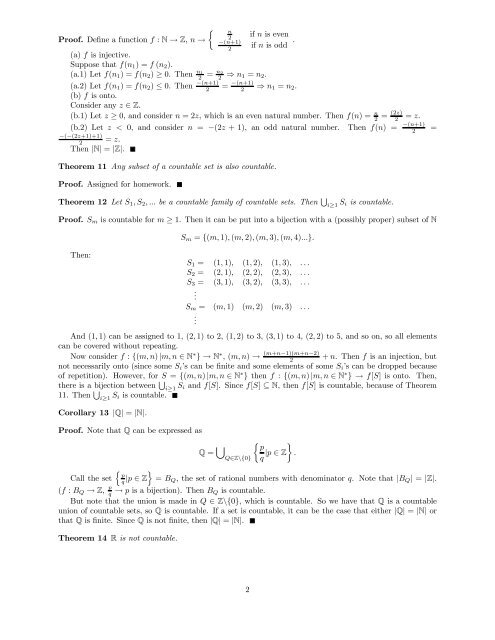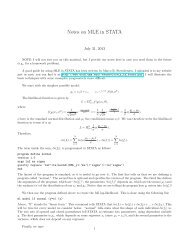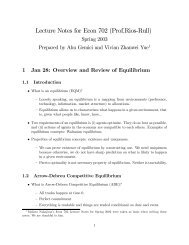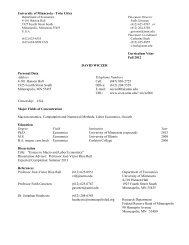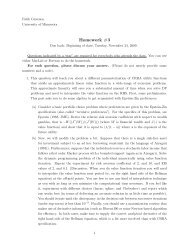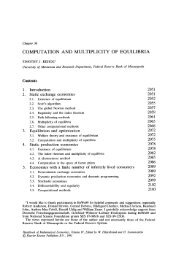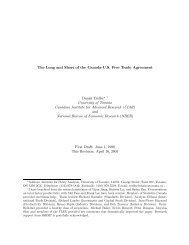Finite, countable and uncountable sets
Finite, countable and uncountable sets
Finite, countable and uncountable sets
You also want an ePaper? Increase the reach of your titles
YUMPU automatically turns print PDFs into web optimized ePapers that Google loves.
½<br />
Proof. Define a function f : N → Z, n →<br />
n<br />
2<br />
if n is even<br />
−(n+1)<br />
2<br />
if n is odd .<br />
(a) f is injective.<br />
Suppose that f(n 1 )=f (n 2 ).<br />
(a.1) Let f(n 1 )=f(n 2 ) ≥ 0. Then n1<br />
2 = n2<br />
2 ⇒ n 1 = n 2 .<br />
(a.2) Let f(n 1 )=f(n 2 ) ≤ 0. Then −(n+1)<br />
2<br />
⇒ n 1 = n 2 .<br />
(b) f is onto.<br />
Consider any z ∈ Z.<br />
(b.1) Let z ≥ 0, <strong>and</strong> consider n =2z, whichisanevennaturalnumber.Thenf(n) = n 2 = (2z)<br />
2<br />
= z.<br />
(b.2) Let z < 0, <strong>and</strong> consider n = −(2z +1), an odd natural number. Then f(n) = −(n+1)<br />
2<br />
=<br />
−(−(2z+1)+1)<br />
2<br />
= z.<br />
Then |N| = |Z|.<br />
2<br />
= −(n+1)<br />
Theorem 11 Any subset of a <strong>countable</strong> set is also <strong>countable</strong>.<br />
Proof. Assigned for homework.<br />
Theorem 12 Let S 1 ,S 2 ,... be a <strong>countable</strong> family of <strong>countable</strong> <strong>sets</strong>. Then S i≥1 S i is <strong>countable</strong>.<br />
Proof. S m is <strong>countable</strong> for m ≥ 1. Then it can be put into a bijection with a (possibly proper) subset of N<br />
S m = {(m, 1), (m, 2), (m, 3), (m, 4)...}.<br />
Then:<br />
S 1 = (1, 1), (1, 2), (1, 3), ...<br />
S 2 = (2, 1), (2, 2), (2, 3), ...<br />
S 3 = (3, 1), (3, 2), (3, 3), ...<br />
.<br />
S m = (m, 1) (m, 2) (m, 3) ...<br />
.<br />
And (1, 1) canbeassignedto1, (2, 1) to 2, (1, 2) to 3, (3, 1) to 4, (2, 2) to 5, <strong>and</strong>soon,soallelements<br />
can be covered without repeating.<br />
Now consider f : {(m, n) |m, n ∈ N ∗ } → N ∗ , (m, n) → (m+n−1)(m+n−2)<br />
2<br />
+ n. Thenf is an injection, but<br />
not necessarily onto (since some S i ’s can be finite <strong>and</strong> some elements of some S i ’s can be dropped because<br />
of repetition). However, for = {(m, n) |m, n ∈ N ∗ } then f : {(m, n) |m, n ∈ N ∗ } → f[S] is onto. Then,<br />
there is a bijection between S i≥1 S i <strong>and</strong> f[S]. Since f[S] ⊆ N, thenf[S] is <strong>countable</strong>, because of Theorem<br />
11. Then S i≥1 S i is <strong>countable</strong>.<br />
Corollary 13 |Q| = |N|.<br />
Proof. Note that Q can be expressed as<br />
Q = [ Q∈Z\{0}<br />
½ p<br />
q |p ∈ Z ¾<br />
.<br />
n o<br />
Call the set p<br />
q |p ∈ Z = B Q , the set of rational numbers with denominator q. Note that |B Q | = |Z|.<br />
(f : B Q → Z, p q → p is a bijection). Then B Q is <strong>countable</strong>.<br />
But note that the union is made in Q ∈ Z\{0}, which is <strong>countable</strong>. So we have that Q is a <strong>countable</strong><br />
union of <strong>countable</strong> <strong>sets</strong>, so Q is <strong>countable</strong>. If a set is <strong>countable</strong>, it can be the case that either |Q| = |N| or<br />
that Q is finite. Since Q is not finite, then |Q| = |N|.<br />
Theorem 14 R is not <strong>countable</strong>.<br />
2


